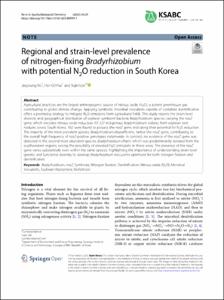GIST Scholar
College of Engineering
Department of Environment and Energy Engineering
1. Journal Articles
Regional and strain-level prevalence of nitrogen-fixing Bradyrhizobium with potential N2O reduction in South Korea
- Type
- Article
- Citation
- APPLIED BIOLOGICAL CHEMISTRY, v.68, no.1
- Issued Date
- 2025-06
- Abstract
- Agricultural practices are the largest anthropogenic source of nitrous oxide (N2O), a potent greenhouse gas contributing to global climate change. Applying symbiotic microbial inoculants capable of complete denitrification offers a promising strategy to mitigate N2O emissions from agricultural fields. This study reports the strain-level diversity and geographical distribution of soybean symbiont bacteria Bradyrhizobium species carrying the nosZ gene, which encodes nitrous oxide reductase. Of 227 indigenous Bradyrhizobium isolates from soybean root nodules across South Korea, 162 were found to possess the nosZ gene, indicating their potential for N2O reduction. The majority of the most prevalent species, Bradyrhizobium diazoefficiens, harbor the nosZ gene, contributing to the overall high frequency of nosZ-positive genotypes nationwide. In contrast, no evidence of the nosZ gene was detected in the second most abundant species, Bradyrhizobium elkanii, which was predominantly isolated from the southwestern regions, raising the possibility of elevated N2O emissions in these areas. The presence of the nosZ gene varies substantially even within the same species, highlighting the importance of understanding strain-level genetic and functional diversity to develop Bradyrhizobium inoculants optimized for both nitrogen fixation and denitrification.
- Publisher
- SPRINGER SINGAPORE PTE LTD
- ISSN
- 2468-0834
- Appears in Collections:
- Department of Environment and Energy Engineering > 1. Journal Articles
- 파일 목록
-
-
Download
 s13765025009997.pdf
기타 데이터 / 2.2 MB / Adobe PDF
s13765025009997.pdf
기타 데이터 / 2.2 MB / Adobe PDF
-
Items in Repository are protected by copyright, with all rights reserved, unless otherwise indicated.